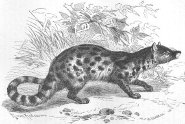 The large-spotted civet (Viverra megaspila) actually resembles a dog, unlike other civets, which resemble cats with spots and long noses. They are known as one of the rarest animals in the world. The large-spotted civet weighs 18-20 lbs. (8-9 kg) and is 30-33.5 inches (76-85 cms) in length. It has a dull grayish white coat with black spots and vertical stripes. The tail has five white rings, black bands and a black tip.
The large-spotted civet (Viverra megaspila) actually resembles a dog, unlike other civets, which resemble cats with spots and long noses. They are known as one of the rarest animals in the world. The large-spotted civet weighs 18-20 lbs. (8-9 kg) and is 30-33.5 inches (76-85 cms) in length. It has a dull grayish white coat with black spots and vertical stripes. The tail has five white rings, black bands and a black tip.The large-spotted civet's original habitat was the evergreen rain forests below the Western Ghats and the wooded plains and hill slopes of southwest India, specifically Malabar and Travancore. Many occurrences of large-spotted civets in the past 30 years have been in valleys and cashew plantations. Cashew plantations provide important cover. They are not weeded and are densely populated with grasses and shrubs. It is believed that large-spotted civets are dependent on shallow waters for survival.
Not much is known about the reproduction and behavior of large-spotted civets. Female large-spotted civets average 2-3 babies per litter. They are often found alone, since they are known for being aggressive toward each other. They are nocturnal, hiding in dense cover during the day and foraging for food at night. They have never been seen in trees and seem to forage exclusively on the ground. Their diet consists of small animals, fish, reptiles, eggs and vegetables.
Once very common in southwest India, large-spotted civets are now nearing extinction. There is said to be less than 250 large-spotted civets in existence. They have been considered critically endangered since 1979, but very few efforts have been made to preserve them. In a 1990 study involving India residents living near the habitats of the civets, only 10 percent were aware of its existence, with most of those trappers, hunters and civet breeders. Extensive deforestation in favor of planting rubber trees has contributed to the extinction of civets. Plus, they are known for preying on poultry, so many farmers kill them when they come into contact with them.
The Large-spotted civet is listed as Least Concern (LR/lc), lowest risk. Does not qualify for a more at risk category. Widespread and abundant taxa are included in this category, on the IUCN Red List of Threatened Species

Custom Search